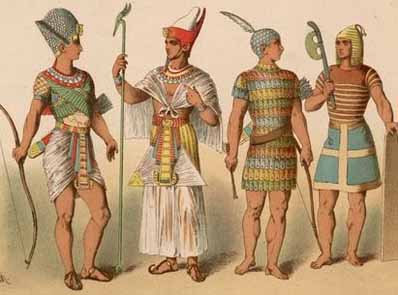

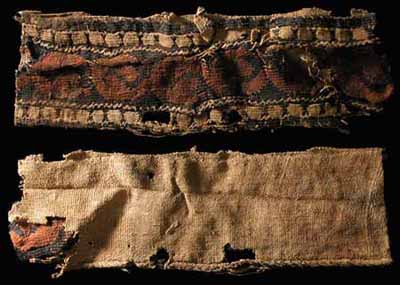
The beginning of the arts of weaving and dyeing are lost in antiquity. Mummy cloths of varying degrees of fitness, still evidencing the dyer's skill, are preserved in many museums.
The invention of royal purple was perhaps as early as 1600 B.C. From the painted walls of tombs, temples and other structures that have been protected from exposure to weather, and from the decorated surfaces of pottery, chemical analysis often is able to give us knowledge of the materials used for such purposes.
Thus, the pigments from the tomb of Perneb (at estimated 2650 B.C.), which was presented to Metropolitan Museum of New York City in 1913, were examined by Maximilian Toch. He found that the red pigment proved to be iron oxide, hematite; a yellow consisted of clay containing iron or yellow ochre; a blue color was a finely powdered glass; and a pale blue was a copper carbonate, probably azurite; green were malachite; black was charcoal or boneblack; gray, a limestone mixed with charcoal; and a quantity of pigment remaining in a paint pot used in the decoration, contained a mixture of hematite with limestone and clay.

Tarkhan Dress: World's oldest known outfit was worn to an ancient Egyptian funeral 5,000 years ago Live Science - June 16, 2025

The world's oldest known dress is a simple V-necked garment that was overlooked as rags for decades.
Fashion for men and women, rich or poor, changed very little over the centuries in Ancient Egypt. The clothing worn by men and women was made of linen, were simple in design, and lightweight for the hot climate. All men, from the tomb worker to the pharaoh, wore a kind of kilt or apron that varied in length over the years, from halfway above the knee, to halfway below it. It was tied at the front, folded in at the side, or in two knots at the hips. A sleeved, shirt-like garment also became fashionable.
Women wore straight, ankle-length dresses that usually had straps that tied at the neck or behind the shoulders. Some dresses had short sleeves or women wore short robes tied over their shoulders. Later fashions show that the linen was folded in many tiny vertical pleats and fringes were put at the edges. Wealthy people wore sandals made of leather that had straps across the instep and between the first and second toes.
The Egyptian climate with its hot summers and mild winters favored light clothing made from plant fibers, predominantly linen and in Roman times occasionally cotton, an import from India. Wool was used to a lesser extent, and seldom by Egyptians proper. Small amounts of silk were traded to the eastern Mediterranean possibly as early as the second half of the second millennium BCE and traces of silk have been found in Egyptian tombs.
Animal skins, above all leopard skins, were sometimes worn by priests and by pharaohs in their role as first servants of the god. Such outfits were found in Tutankhamen's tomb and were depicted quite frequently on the walls of tombs. At times kings and queens wore decorative ceremonial clothing adorned with feathers. The manufacture of clothes was apparently mostly women's work. It was generally done at home, but there were workshops run by noblemen or other men of means.
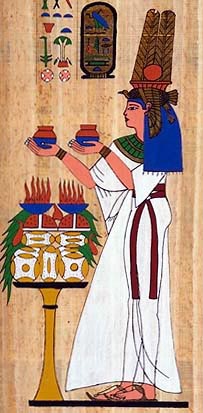
Basic garments with minor variations accounted for fashion, social status and wealth did not change fundamentally throughout Egypt's history. Very little sewing was done. The cloth was wrapped round the body and held in place by a belt. Its color was generally whitish, in contrast to the colorful clothes foreigners wore in Egyptian depictions, although dyed cloth was not unknown.
Everyday clothing was mostly undecorated, though pleating was known since the Old Kingdom, when some dresses of upper class Egyptians were pleated horizontally.
In the New Kingdom the pleats were often vertical, but pleating could be quite intricate. A Middle Kingdom piece of clothing displays three different types of pleating: one part is pleated with pleats a few centimetres apart, another with very narrow pleats and a third part is chevron-patterned, with horizontal and vertical pleats crossing each other. How the pleating was done is not known, but it is generally supposed to have been very labour intensive.
The length of the the kilts varied, being short during the the Old Kingdom and reaching the calf in the Middle Kingdom, when it was often supplemented with a sleeveless shirt or a long robe. Linen kalasiris, New Kingdom; Source: University of Indiana website The robes worn by both sexes in Egypt were called kalasiris by Herodotus. Material and cut varied over the centuries, though the cloth of choice was always linen. The kalasiris women wore might cover one or both shoulders or be worn with shoulder straps. While the top could reach anywhere from below the breast up to the neck, the bottom hem generally touched the calves or even the ankles. Some had short sleeves, others were sleeveless. The fit might be very tight or quite loose. They were often worn with a belt which held together the folds of cloth.
They were sewn from a rectangular piece of cloth twice the desired garment length. An opening for the head was cut at the centre of the cloth, which was then folded in half. The lower parts of the sides were stitched together leaving openings for the arms.
Women's dresses were at times ornamented with beads. They covered the breasts most of the time, though there were periods when fashion left them bare. Circular capes date back as far as the Old Kingdom. They were generally made of linen and had an opening for the head cut at the centre. They were often dyed, painted or otherwise decorated and covered little more than the shoulders. Shawls were sometimes worn during the New Kingdom.
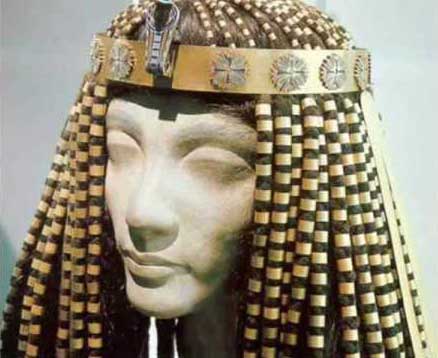
Headdresses and crowns were very popular especially with royalty - the headdress have significance and bring a message about the wearer. The pharaohs are always represented wearing crowns, but whether this is a pictorial convention or whether they did so in every day life can not be decided.

Egyptians adorned themselves with as much jewelry as they could afford. Pairs of bracelets were worn around the wrist or high on the arm, above the elbow. Rings and anklets were also worn. Women wore large round earrings and put bands around their heads or held their hair in place with ivory and metal hair pins. Ordinary people wore necklaces made of brightly colored pottery beads.
2,600-year-old jewelry stash from ancient Egypt includes gold statuette depicting family of gods Live Science - March 7, 2025
Archaeologists in Egypt have discovered a 2,600-year-old pot full of gold jewelry, including a rare statuette that depicts a family of gods and may have been worn as an amulet. A team found the pot at Karnak Temple, a complex near Luxor (ancient Thebes). The temple was initially built around 4,000 years ago and was continuously expanded, renovated and modified over millennia. A number of deities were worshipped at the site, including Amun, the chief god of Thebes. The finds include beads, amulets and statuettes, many of which are gold, according to a translated statement from the Egyptian Ministry of Tourism and Antiquities.
Far Out: Ancient Egyptian Jewelry Came from Outer Space Live Science - August 20, 2013
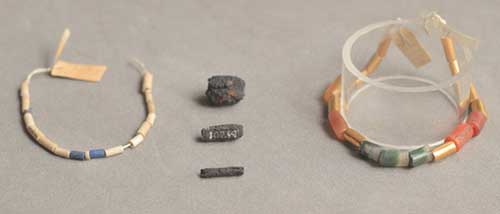
Ancient Egyptian beads found in a 5,000-year-old tomb were made from iron meteorites that fell to Earth from space, according to a new study. The beads, which are the oldest known iron artifacts in the world, were crafted roughly 2,000 years before Egypt's Iron Age. In 1911, nine tube-shaped beads were excavated from an ancient cemetery near the village of el-Gerzeh, which is located about 3,100 miles (5,100 kilometers) south of Cairo, said study lead author Thilo Rehren, a professor at UCL Qatar, a Western Asian outpost of the University College London's Institute of Archaeology. The tomb dates back to approximately 3200 B.C., the researchers said. Inside the tomb, which belonged to a teenage boy, the iron beads were strung together into a necklace alongside other exotic materials, including gold and gemstones. Early tests of the beads' composition revealed curiously high concentrations of nickel, a telltale signature of iron meteorites.
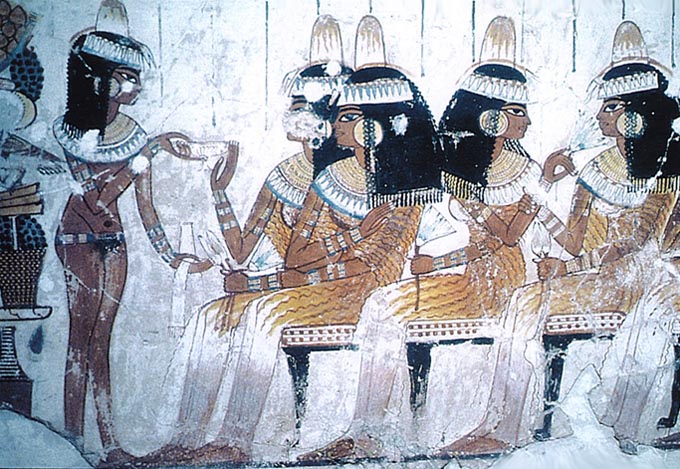
A tomb painting of a servant girl and four elegantly dressed women at a funerary banquet. The guests wear wigs, gold earrings, jeweled collars, bracelets, and pleated dresses. On their heads are scented ones of animal fat that release perfume as they slowly melt. Several women are holding lotus flowers, which were typically distributed to banquet guests as they arrived. This wall painting appears in the tomb of Nebamun at Thebes and dates to about 1400 B.C.E.
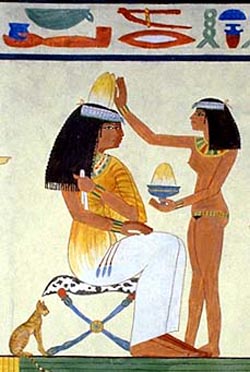
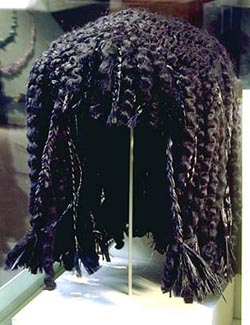
The Egyptians cared about their appearance. The women spent a lot of time bathing, rubbing oils and perfumes into their skin, and using their many cosmetic implements to apply make-up and style their wigs, worn by men and women. A woman would place a cone made of fat soaked in sweet smelling ointment on her head, which slowly melted over her wig during a warm evening. Men were always clean-shaven, using razors made from bronze to shave their beards and heads.
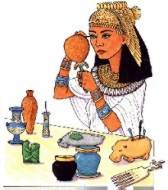
Both men and women wore blue and green eyeshadow and black eyeliner. Using a highly-polished bronze hand mirror, a woman would apply khol, a black dye kept in a jar or pot, to line her eyes and eyebrows, using an "brush" or "pencil" made of a reed. Men also wore this eye make-up as well, which was not only a fashion but also protected against the eye infections which were common in Egypt.
They would use a dye called henna to redden their nails and lips.
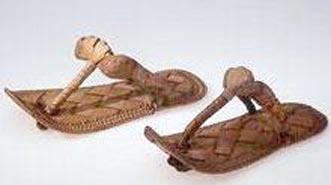
People living around the Mediterranean had little need for elaborate footwear, with exceptions like the Hittites in their Anatolian highlands who wore shoes with turned up toes, though in Egyptian reliefs Hittites are depicted unshod. The Egyptians went barefoot much of the time, but wore sandals on special occasions or when their feet were likely to get hurt. The sandals were tied with two thongs and, if they had a pointed tip this was often turned upwards. They were made of leather or rush woven or stitched together, and often had leather soles and straps. The cheapest kind of sandals were affordable to all but the very poorest.
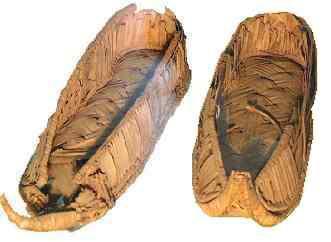
Early Middle Kingdom shoes were little more than sandals with straps between the toes and joined to the sides at the heel with the upper leather just covering the foot without being fastened to the foot itself. During the New Kingdom there were times when some Egyptians seem to have taken to occasionally wearing shoes, as in Rush slippers, Late Period, Source: cesras website a depiction of Queen Nutmose at Karnak. This may have come about as an influence of the Hittites, with whom they came into contact at this time.
Before the advent of industrial production techniques, cheap overseas transportation and a Third World population with little choice but to work for peanuts, clothes made up a considerable part of one's living expenses. Even though the clothes of the Egyptians were lighter than those of Europeans and less critical to survival, they were careful not to ruin them, and when a garment got torn, it was probably the ancient Egyptian housewife who got her favorite needle out of her needle box, a knife and a piece of thread and settled down to mend it. Garments have been found which were mended a number of times and finally recycled and turned into something else.

Cleanliness was apparently next to godliness in ancient Egypt. And who was closer to the gods than the pharaohs themselves. Since earliest historic times the titles of "chief washer of the palace" and "washer to the pharaoh" are known, and keeping the royal clothes lily white was the duty of the "chief bleacher."
Manually washing clothes was hard work. Soap was unknown to the ancient Egyptians, so lye, made of castor-oil and saltpetre or some such substances , or detergents made of soapwort or asphodil were used. The laundry was beaten, rinsed and wrung by pairs of workers. By 1200 BCE there were fire-proof boilers in the wash-houses, and the hot water lightened the workload.
Many, above all the poorer people had no access to facilities and had to do their laundry under at times difficult conditions. Washing on the shore of the river or the bank of a canal, which had the advantage of not having to carry a lot of water in heavy earthen pots, could be dangerous